Surf fins and dynamic ADAC System™ technology
FYN dynamic fins ADAC System™ technology: a real technological advance in surf riding and surfboards fins.
"This evolution of the active principle of the surf fin, marks a real revolution in the hydrodynamics of the drifts by bringing an exceptional fluidity and the feeling of a board that sticks to the feet, answering instinctively to the slightest movement!"
"This biomechanical technology of variable geometry profiles brings the maneuverability and acceleration provided by fins and derivatives into a new era!"
Many prejudices circulate in the surf. Let's sharpen our intuition of the glide with a zest of technical and scientific argumentation ...
Let us, therefore, underline the description of this biomechanical fin technology, leaving the precise and quantified arguments of the designers, specialists in hydrodynamics, to establish the usefulness and innovativeness of the ADAC patents. (Adaptive Dynamics Attack & Camber US patent14859193/ 2015 & FR 1402226/2014 applied to surf by FYN http://fynsurf.com/)

FYN DYNAMIC surf fin, a variable geometry fin using the ADAC SYSTEM: (Adaptive & Dynamics Attack & Camber)
The concept of static and dynamic weights is essential to objectively address the quality of a surf fin:
- The static weight is easy to gauge, with a scale for example. This weight is a widely used argument but it has a slight impact on surf performance: a glass of water drunk before (or during) the session, is heavier than the maximum difference between 2 fins of carbon or conventional technology!
- The "dynamic weight" is visible in the action: it represents the resistance to progress with the board. Thus a flap that has an inappropriate angle, or that generates a stall, causes a drag and therefore a dynamic weight much more responsive and sensitive than its static weight:
We will see below in detail, how the dynamic weight of a fin can go from 0,15 Lbs to 2 Lbs, in the same wave phases, if its camber and its incidence do not adapt correctly to the direction of the fluid! A board equipped with 3 fins can therefore go from 0.4 Lbs to 6 Lbs of dynamic weight! Worse than that, this dynamic weight increase is often accompanied by a loss of grip performance. The static weight variation between 2 types of fins, whose order of magnitude rarely exceeds 0.22 Lbs, seems secondary because they represent about 30 times less than the variations in dynamic weight. It’s this type of hydrodynamic analysis that initiated the ADAC System™.
This surf fins technology results from 3 axes of research & development that we will summarize here:
- Historical study of the evolution of the fin in the practice of surfing: the genes to preserve.
-
Theoretical study of hydrodynamics, kinematics and mechanics of the drifting problem.
- Advantages of the ADAC System™.
- Analogy with the types of turns in Ski or Snowboard.
- Influences of camber parameters and incidence of hydrodynamic profiles.
- ADAC System™ influence on resistance dragging surf fins.
- ADAC System™ influence on the lift of the surf fins.
- ADAC System™ influence on efficiency range and stall.
- ADAC System™ influence on surf acceleration.
- ADAC System™ influence on the rail catch by limiting the effect of cant.
- ADAC System™ influence on the reduction of vortex losses (winglet effect).
- ADAC System™ influence on safety (anti-cut fins).
- Intuitive experience of prototypes, and search for natural sensations.
1 - Study of the evolution of the fins in the surfing history
The 11 basic genes:
Before going further in the description of the system of fins and fins ADAC System™, and demonstrate the real contribution that it offers to the state of technique, check if this system integrates the best of what has been done in its genes .
Since 1934 (Tom Blake), fin designers have shown various forms with varied objectives. We will only mention 11 basic "genes" in the genealogy of the fin, because dozens of models deserve to be mentioned for their participation in this evolution. We have put aside the purely aesthetic factor, which remains an important argument in a medium where the effect of fashion has solid anchors. For a more in-depth study of the history of the fin, I invite you to consult the page: www.surfresearch.com.au

In the beginning, there was ... waves and instinct.
Gene #1
Need creates the function of the fin instinctively, by varying the shapes of our hands to direct us in the wave.
No historical trace of the inventor, we should look at the prehistoric level and certainly beyond in our genetic memory... or closer to us, in the sensation of the present moment.Gene #2
The variations of the wing's incidence according to the need
In history, every sinner civilization has developed its own experience of waves and a way of sliding over them. We will not discuss here the anteriority of the discovery because the instinct of sliding is universal. Tales of travels in West Africa (1600) tell the agility of the boatmen in the waves, in this case, the oar serves as a drift that is oriented to steer the pirogue in the wave.
The paddle serves as a drift that is oriented to steer the canoe in the wave

Surfboards will remain finless for long time, the rail is the only way to hang the wave.
Gene #3
Here we will remember that hanging on the rail in speed, straight line, without transverse skid, our fin should not slow us down and only be forgotten.
The first surfboards observed during Cook's trips (1769) to the Sandwich islands describe finless long boards, and the first photography of surfers (1890 - Sandwich surfers, surf type alaia without fins) show us a finless Alaia shape. Surfboards will remain finless for long time, the rail is the only way to hang the wave.Gene #4
The fulcrum and the pivot allow the turn, but we will also remember that a technological advance must include security and ease of integration to be shared
But the need to take support to modify the trajectory without slipping (Slide) is real, and move their longboards without fin, old time surfers (1930-1940) briefly dive the foot in the water to turn the board... We attribute the invention of the surf fin to Tom Blake in 1934, salute to this genius surfer who embodies the creative spirit of the shaper/surfer. The implantation of this fin revolutionizes surfing by allowing new possibilities of tricks and movements. It stabilizes the trajectory and creates a support on a rear pivot to turn and change direction. But despite its undoubted effectiveness, this innovation proposed by Blake in 1934, takes time to be adopted, because of a relative difficulty of establishment and the danger which it represents in the eyes of the surfers, the fin will remain hidden for some years.
Photo and caption handwritten by Tom Blake. Surfer Magazine, March 1981

From 1935 to 1960 the height of the fin continues to increase
Gene #5
The importance of the surface in the 1960s
From 1935 to 1960 the height of the fin continues to increase, the fulcrum is more and more efficient and allows more and more tight turns, the radicality of the cut back and the bottom turn are linked to this evolution.Gene #6
What about security
In the 60's, the evolution of new materials allowed greater lengthening, and safety became an argument, we note in 1960 the POPOUT system which is expected the fin to be removed during a shock.
1960 the POPOUT system which is expected the fin to be removed during a shock

One good fin is better than two opposites
Gene #7
One good fin is better than two opposites
Around 1964 while the Twin (2 fins) spreads, Greenought tests Twin fins and systematically bring closer, as long as it gains efficiency, it ends up bringing them closer so much that it finds that only one well sized fin is more efficient! No, the twin is not dead and the multi fin has a bright future ahead, but let's remember that less is more!Gene #8
Variable geometry depending on forces!
In the 70's, Greenought developed single fin, with a high elongation: to allow accumulated maneuverability, it decreases the width (chord of the profile) which induces a rail effect, and it increases the height (reduction in vortex losses) to maintain the surface which generates a support closer to the nose of the board. At the same time, it introduces the Rake (rearward angle) and the flexibility, the combination of which allows the geometry to change under constraint.The principle of Greenought: it lengthens, thins and gives rake to bend the tip of the fin in the direction of flow. A feeling of flexibility and fluidity in the maneuvers is introduced. This drive effect is proportional to the length of the fin, its rake and its flexibility (today we can find S-Wings fins working on this principle).
Warning, the exaggeration of this principle generates:
- Long, thin cutting sabers increasing the risk of injuries.
- Lift centers offset from the board, producing tilting and overturning effects, reducing the grip of the rail.
- A reversal of curvature of the upper surface which can induce the stalling of the leading edge.

Variable geometry depending on forces!

Cundith fin in 1977
Gene #9
Structure work
In 1977, Cundith worked on a structure combined with a material allowing flexibility of the surf fin.Gene #10
The importance of incidence and its adaptation to conditions
In 1998 Swivel Fin introduced an adjustable incidence concept which is certainly the result of a more scientific hydrodynamic approach to the performance of foils according to their incidence.
Fin from Swivel Fin in 1998

Winglets at the end of aileron inspired by aeronautics
Gene #11
Limit vortex losses when the lift concentration is high
Around 1984-86, winglets appeared at the end of the aileron, inspired by aeronautics, they reduce vortex losses at the end of the fin, the winglet provided gains for the fin with low elongation, the center of lift close from the edge generates a lot of vortex losses, for large ailerons, the efficiency is lower and you have to be careful not to unnecessarily increase the dragged area...2 - Hydrodynamic, kinematic and mechanical theoretical approach to the problem of the surf fin (fin)
The specifications of a surf fin are particularly complex because it varies depending on the surfer, the board and the wave in constant transformation.The conditions encountered in the trajectory of a single wave: speed gain, grip, dynamic turns, curves, revival, pumping ... are all specific moments, where the functions of the surf drift vary and even oppose sometimes.
We will see for example, that the dynamic weight (drag of resistance to advancement) of a single fin can pass, from 70 grams for a correctly oriented fin, to 900 grams if its camber and its incidence do not adapt to the direction of the fluid!
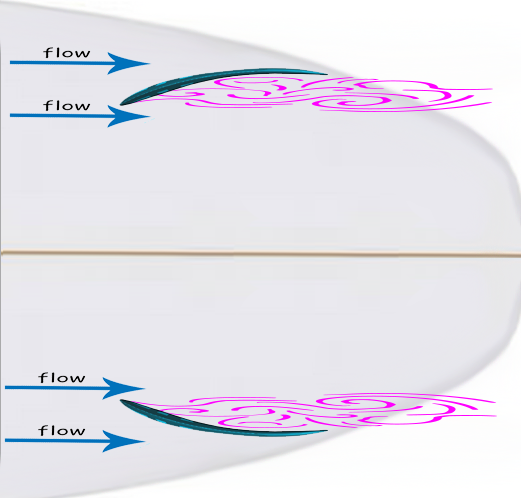
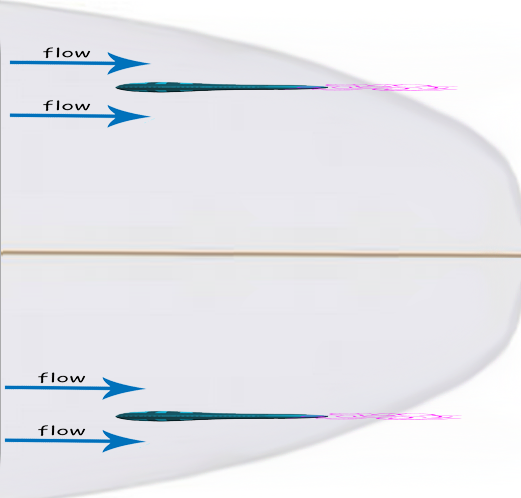
This dynamic evolution of the specifications of the surfboard drift, highlights the necessity and the major asset of the dynamic system with reactive biomecanic structure of ADAC system.
Theoretical analysis and careful experimentation, combined with an uncompromising design strategy, led to the following exceptional results:
- Automatic variation of the incidence and the camber generating a constant optimization of the finesse (lift / drag ratio) and the reduction of the "dynamic weight".
- Dynamic parallelism of the fins limiting drag and "dynamic weight" by providing permanent synchronization of the performance of each opposite fin.
- Ultra-fast lift from low angles of attack (120 newtons from 10 degrees for a speed of 14m/s - 31mph).
- Maximum grip only on demand due to variable camber controlled by forces generated by the surfer (progressive (negative and positive) camber variation range from 0 to 35%).
- Horizontal pumping, maximum speed gain due to a conversion of transversal movements in acceleration (Bilateral orientation of 45 ° of the projection of lift transforming all lateral components into propulsive force).
- Generation of thrust due to the undulating movements of the paddle phases.
- High position of the aileron lift centers favoring the grip of the rail by limiting the cant effect.
- Total erasure of the camber and the incidence in the rectilinear trajectories of the acceleration phases offering a residual drag ("dynamic weight") almost zero (0.7 newtons at 4m/s - 9mph).
- Multi-material biomechanical structure ensuring solidity, elasticity and safety due to the flexibility making cuts impossible.
- A "fusible" part calculated to deform when a force 2 times greater than the water can produce in the most radical maneuvers, is applied to the system. This fuse protects from knocking shocks and ruptured boxes.
- 5 different materials combined in an aeronautical technology structure composed an articulated kinematic chain allowing controlled elasticity and winglet effect.
- Advance of the axis of rotation at the level of the spine generated by the automatic incidence variation. This positioning of the fictitious axis of rotation allows a more balanced surfing position and engaged in maneuvers, inducing a more horizontal board glide favoring speed conservation.
- A new and instinctive feeling of the action of the ailerons thanks to their dynamic response to impulses and the alignment of the center of rotation on the spine which provides a real experience of intuitive and natural trajectories.
Analogy with Ski or Snowboard.
We can compare the turns with static fin and FYN surf fins, with skid or cut ski turns:
-
At a higher technical level, the skidding turn has major drawbacks:
- It is not suitable for cornering at high speeds. Indeed, the centrifugal force is such that the surfer cannot stay in his trajectory.
- It does not allow a sufficiently precise control of the board.
- It does not allow you to rotate in a limited space.
- It is an important source of speed loss.
- It positions the body too far back to perform a quick raise.
- The cornering cut allows precise cornering at high speeds. The speed loss is very low. In addition, the support remains centered throughout the driving phase of the turn and control can be very effective and intuitive. The position of the body remaining centered and the recovery is immediate
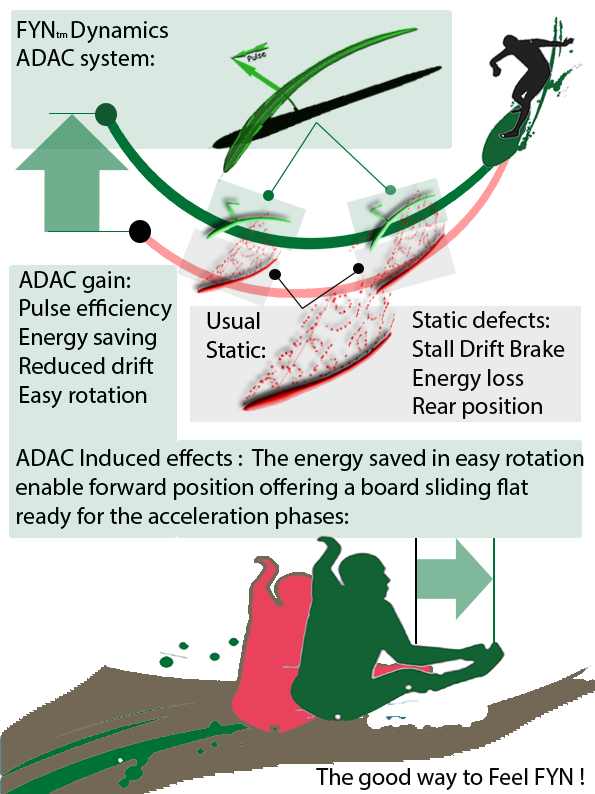
Let's be more precise (if you still follow...) in the description, and let's get to the heart of the hydrodynamic problem of surfboards:
Influence of camber parameters and incidence of hydrodynamic profiles
The theoretical performances of the best hydrodynamic profiles are known and listed by specialists in databases (See Heliciel database), and we know how the performances of drag and lift vary according to the incidences, camber, and speeds.

(fig 1)

(fig 2.1)
Symmetrical surf fin profiles
There are effective profiles at low angles of incidence, but which suddenly drop off at the largest angles and this produces, for example, a loss of cornering support (stall or spin out) due to the increase in incidence caused by the curved trajectory. We will take for example here (fig 2.1) a symmetrical profile the NACA 0008.

(fig 2.2)

(fig 2.3)
Cambered surf fins (fins)
There are effective profiles at large angles of incidence, but which generate significant drag even when they have zero incidence, this is harmful for the acceleration phases. We will take for example here (fig 2.3) a cambered profile the NACA 9505.

(fig 2.4)
Here (fig 2.4) is the drag curve and finesse as a function of the variation in incidence at a given speed for a fin with this profile.
Influence of the ADAC system on the drag resistance of the advancement of the surf fins
The comparison of the curves of these 2 profiles (fig 2.1 and 2.3) show a very low drag (green curves) (0.7 newtons) at zero incidence for the symmetrical profile (fig 2.2). While a curved profile (curve fig 2.4) generates 8 newtons of resistance to advancement.
In straight trajectory there is therefore an obvious interest in using a symmetrical profile. To have an element of judgment, let's take the 2 opposite fins of a twin, with an angle of 4 degrees of incidence set by the shaper: 9 + 9 = 18 newtons of resistance, or almost 2 kilos to push at the end of the legs :

The ADAC system aligns the fin at zero incidence and removes the camber when the trajectory is parallel to the axis of the board (it also retains the parallelism of the ailerons whatever the angle), therefore a delta of 18 -1.4 = 16.6 newtons of trail removed:

Influence of the ADAC system on the lift
An arched profile therefore generates a significant lift force even at low angles of incidence (fig 2.4). The slightest slippage, or lateral displacement component, transforms the profile of the ADAC system into a cambered profile which generates more lift, therefore more camber, therefore more lift ...

The feedback effect of this grip loop generates an almost immediate recovery of the trajectory, which makes the system very reactive and reduces the time spent adjusting direction.
In our example a symmetrical fin (curve fig 2.2) must be placed at 40 degrees of incidence to generate 120 newtons of lift while the fin with variable camber of the ADAC systm already offers 120 newtons at 10 degrees (curve fig 2.4 ) and rises to 160 Newton at 15 degrees, i.e. an involuntary sliding amplitude at the rear of the board 4 times less for the ADAC system.
The variation in camber of the ADAC system therefore makes it possible to combine the performance of a symmetrical profile, which is optimal during straight paths or at very low incidence, with the performance of various profiles whose camber evolves to generate maximum liftings at from 5 degrees of relative incidence up to 25 degrees without sudden stall.
Influence of ADAC system on the efficiency range and dropout
Beyond about 30 degrees of incidence, whatever the shape of the profile, a phenomenon of hydrodynamic stalling more or less suddenly degrades the lift of a conventional fin (see curves fig 2.2 and 2.4).
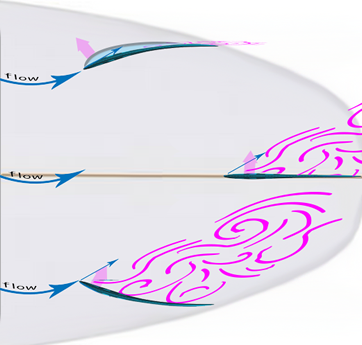
The adaptability of the angle of incidence of the ADAC system (fig 1) maintain an optimal angle of incidence by pivoting the profile following the path of the fluid, maintaining effective relative incidences repelling the stall effect even in the tightest curves.
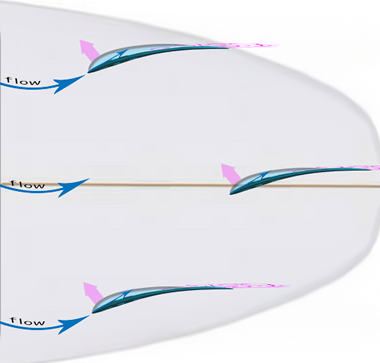
Influence of ADAC system on acceleration
The variation of the incidence and camber is programmed "mechanically" by a controlled elastic structure (aeronautical technology patented by FYN surf) forming an articulated kinematic loop: the kinematic chain of the ADAC system reacts lateral constraints when the trajectory incorporates a drift component. The kinematics of the ADAC system causes the tilting direction of the fin to tilt forward, generating a propulsion and acceleration. This lift projection generated by the ADAC system brings two major advantages:
- Creation of a natural ability to produce speed during particularly instinctive alternative lateral movements (pumping) comparable to a dolphin or fish tail movement.
- Accelerations during turns providing a dynamic trajectory opening up perspectives of figures that would be impossible without this technology.
Influence of ADAC system on rail grip by limiting the cant effect
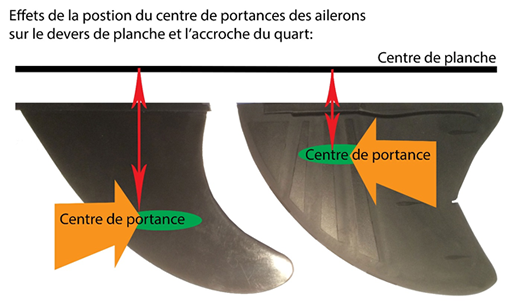
A center of thrust close to the board, limits its cant and the effort required to stick the rail in the wave. Long drifts unfortunately increase the tilting effect which tends to overturn the board when there is a lot of weight applied. The ADAC system provides drive and 70% more thrust thanks to its dynamic leading edge and camber, while keeping a center of thrust very close to the board in order to reduce the slope.
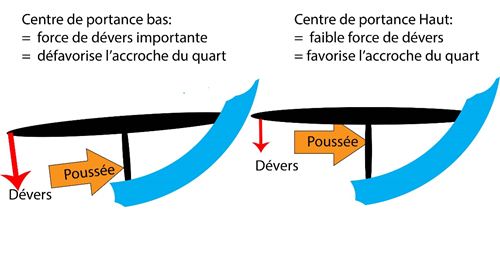
Influence of the ADAC system on the reduction of vortex losses (winglet effect)
Short wings with high lift emit marginal vortices which can degrade lift performance (vortex losses). Some birds, like eagles, have feathers at the end of their wings, forming an inclined surface exploiting and limiting these vortices.
These flexible and profiled surface is integrated at the end of the ADAC fin structure to deform naturally under the effort of lift while respecting this principle.
Influence of ADAC system on safety (anti-cut fins)
One of the major advantages of the ADAC system is that it increased performances and security. The observation from the analysis of the hydrodynamics of the fin is that high performance is not synonym of rigid and sharp structures. The fin profiles of dolphins or whales are proof of this. Their flexible structure generate optimal hydrodynamic forms adapting to the various propulsive phases:
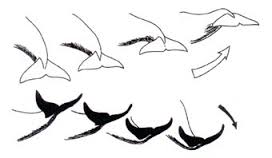
The biomimetics (technology inspired by the biological study) of the ADAC system results from a detailed analysis of these ultra-efficient dolphins fins.
The elasticity of the materials forming the slender parts of the structure of the ADAC system, were exposed to "crash tests" showing the advantage of the flexible zones combined with the twisting of the structures to protect the body of the surfer in case of impacts with the fin. the designers of the ADAC system opted for a controlled break, damaging the fin instead of the surfer or his board.
- Anti cut thanks to the flexibility of the slender parts.
- Protection against knocking impact and ruptured boxes: a "fusible" part deforms at violent impact with solid bodies.
3 - Intuitive prototype experimentation: The search for natural instinctive surf sensations
- The biomechanical structure of the ADAC system generates an intuitive hydrodynamic surf experience with organic logic in impulse in phases.
- The addictive reactivity resulting of the patented the ADAC system and all tests sessions have optimized the acceleration pulses and sequences of trajectories.
- The fluidity of the body's instinctive movements in the curves generates the expression of the natural human marine instinct.
To share with surfers who are interested in the hydrodynamic approach and its arguments, I invite you to send your comments to _contact@fynsurf.com_
JF Iglesias,
Research and development - FYN surf.
Kenny Dorion,
Design and communication - FYN surf.
ADAC Licensing & Patents Legal Contacts:
Europe patent attorney :
Cabinet Gasquet 74000 Annecy France
USA patent attorney:
CIONCA Law Group P.C. Irvine, CALIFORNIE 92614
To obtain ADAC system licenses in various hydrodynamic / aerodynamic branches, you can contact the owners of the Patents via _contact@fynsurf.com_







